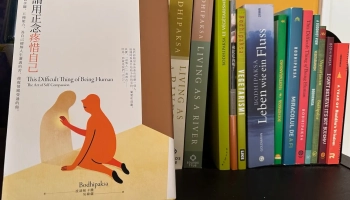
[ad_1]

Milarepa was a famous Tibetan meditation practitioner and Buddhist teacher who lived from 1052 to 1135. He said, “When you run after your thoughts, you are like a dog chasing a stick: every time a stick is thrown, you run after it. Instead, be like a lion who, rather than chasing after the stick, turns to face the thrower. One only throws a stick at a lion once.”
What a wonderful image!
Your Mind Like a Dog
First, the mind being like a dog. Isn’t that so familiar? Dogs aren’t very reflective. Neither are we, most of the time. A thought appears in our minds, and our attention goes chasing after it automatically. Like a dog chasing a stick, we pursue the thought, take it up, and chew it over.
In meditation, thoughts arise quite often, because even though part of you intends to meditate and quiet the mind, other parts of your brain are scanning your experience to see if there are any threats to your well-being that need to be dealt with.
Also see:
If, as is usually the case, there’s nothing threatening going on in your immediate experience, these parts of your brain will comb through memories of things that happened in the past, or look at your future itinerary, and look for things that might be of concern. And so, for example, you might dredge up an encounter where your feelings got hurt, and you replay the events, often in multiple ways, “workshopping” various scenarios. Or you might think about something coming up that’s maybe a bit scary, and start imagining all the things that might go wrong.
You more from a simple thought — maybe just a snippet of a conversation, or a snapshot image — to a full-on drama.
Buddhism talks about this as prapañca, or “proliferation.”
Your Mind Like a Lion
But then there’s the lion. Your mind is like a lion when it sees the stick of a thought flying by, and instead of chasing the stick, it turns toward the stick thrower. It lets the thought pass. It recognizes that an attempt has been made to distract it. It is not taken in by that attempt. It is curious about what this entity is that is trying to manipulate it. And so it turns and looks.
The Stick Thrower
Who is throwing the stick? In Buddhist terms we’re back to Māra. Māra is a mythological personification of distraction. He’s the mental trickster who wants us to be distracted and reactive. He wants us to chase the sticks he throws. Māra is that part of us that’s always trying to throw us off-balance.
How to Do This
Maybe turning to face the stick-thrower isn’t something you’ve ever done. So how to we get started?
It can help to feel the lion quality of your mind. Think of a lion’s steady eyes. Its low growl. Its strength. Its fearlessness. Let those qualities fill your mind and your body. Try it right now, as you observe the space of your mind. If you’re anything like me, it probably feels pretty good.
So sometimes when I’ve seen my mind go chasing sticks in my meditation a few times, I’ll turn toward the place where thoughts come from. And I’ll observe it, waiting to see what happens.
But then I go further, and dare Māra to tempt me.
Calling Out the Devil
I’ll say something like “Come on, Māra. Show me what you got. Show me what you’re made of.” And then I’ll just watch, like a lion, and see what he comes up with. The watching is imbued with lion energy — a sense of strength, confidence, and courage. I feel this energy in my body as well.
I can remind myself that the sticks, or thoughts, are really illusions. They’re not real events that I have to deal with. They’re mental fabrications.
Usually after a few of Māra’s sticks have flown past me, my inner dog will make an appearance again. And so I have to keep on summoning the inner lion, and turning back to face the stick thrower.
And so I’ll say, once again, “Good one, Māra! Clever trick. Your illusion fooled me that time. For a while. So, what else do you have?”
Wildmind is an ad-free, community-supported meditation initiative, supported by sponsors. If you find this website helpful, you’ll love the access that Wildmind’s sponsors get to the meditation courses and other resources that I make available to them. Click here to learn more.
[ad_2]
Source link






